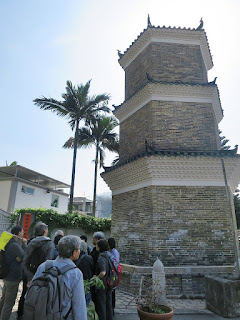The HKSQ
Quality of Life (QoL) Series had launched since 2013 and it aims to bring
social activities to our members other than professional seminars, workshops or
visits. Mr. CP Chow (Former Chairman, HKSQ)
is our leader to introduce different historical location in Hong Kong to
us. In this year, "Ping Shan
Heritage Trail Walking Tour" was organized by Hong Kong Society for
Quality (HKSQ) on 1st April 2017.
The Ping Shan Heritage Trail was inaugurated on 12 December 1993. Stretching about 1.6 km in length, the Trail
meanders through Sheung Cheung Wai (上璋圍), Hang Tau
Tsuen (坑頭村) and Hang Mei Tsuen (坑尾村). It links up a
number of traditional Chinese buildings within easy walking distance of each
other to provide visitors with an opportunity to learn more about traditional
life in the New Territories. In this
morning, we gathered in the Tin Shui Wai West Rail MTR Station.
In the
beginning, Mr. CP Chow led us to go to the Tsui Sing Lau Pagoda (聚星楼). It was built by
the seventh-generation ancestor, Tang Yin-tung, to avoid evil spirits from the
north, prevent floods and help the Tangs win a title in the imperial
examination. He also explained the
decoration of each corner was the tail of phoenix.
Then he demonstrated the map for today walking way.
After that CP
said if you walked around the Pagoda 3 times in anticlockwise direction, you
may get a lucky to become an officer in the government.
Minda and I
took a photo in front of the Pagoda for memory.
We then walked to the Declared Monument – Tat Tak Communal Hall (達德公所) which was built in 1857. Now it was under maintenance by government.
CP also
briefed the road temple to us and then we went to Sheng Cheung Wai (上璋圍).
We visited the
old well and took a group photo. CP said
men went to the temple and women with children talking around the well in the
past.
The next
station was Tang temple which had long history with scholar award in Qing
dynasty.
Here is the Imperial
Academy (Hanlinyuan -翰林院) and the name “庶吉士” means the trainee or post-graduate student.
We took a
group photo in front of the Hanlinyuan.
Outside the Hanlinyuan, there were some special snacks for sell, it tasted very good!
After that we
went to the entrance hall of Shut Hing Study Hall (述卿書室) which established in 1874. Inside was Hung Shing Temple (洪聖宮).
Visited the
Tang Ancestral Hall, we went to Ping Shan Tang Clan Gallery. We climbed a small high land and then reached
the gallery.
CP said the
gallery was policy station in the past and the top was in Red color. It was because the village sharp like crab
related to Feng Shui in the past. So British knew that and asked people to use
red color indicating that crab was well cooked!
After 1997, the color was changed to be green again.
Reference:
Other HKSQ Quality Life Series activities:
20130124 -
The historical development of Sheung Wan Hong Kong Island for the past 100
years (港島上環區百年變遷講座)
20130126 -
The historical visit to Sheung Wan Hong Kong Island for the past 100 years (港島上環區百年變遷考察)
20130914 -
HKSQ Tour to Heritage Sites of Central District
20140112: HKSQ
Oyster Shucking and Wine Pairing Workshop - https://qualityalchemist.blogspot.hk/2014/01/hksq-oyster-shucking-and-wine-pairing.html
20150228: HKSQ
QoL Walking Tour to Tai Ping Shan Medical - https://qualityalchemist.blogspot.hk/2015/02/hksq-qol-walking-tour-to-tai-ping-shan.html
20151212: HKSQ
Iberico Ham and Wine Pairing Workshop - https://qualityalchemist.blogspot.hk/2015/12/hksq-iberico-ham-and-wine-pairing.html
20160109: HKSQ
QoL Lei Yue Mun Village Heritage Walking Tour - https://qualityalchemist.blogspot.hk/2016/01/hksq-qol-lei-yue-mun-village-heritage.html














沒有留言:
發佈留言